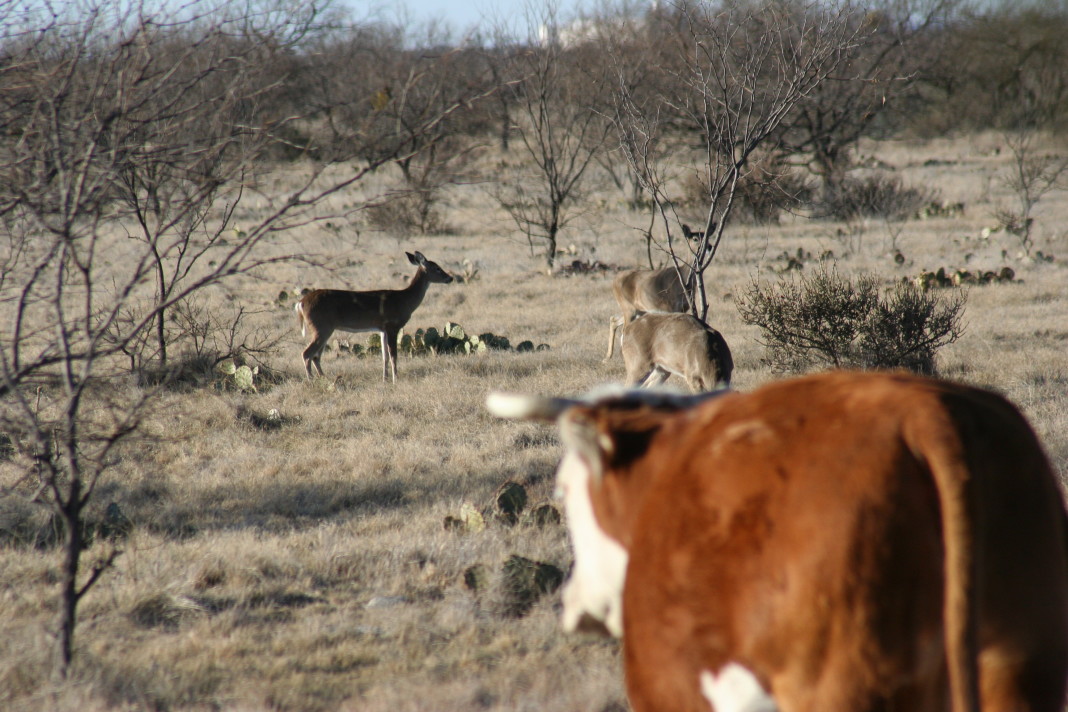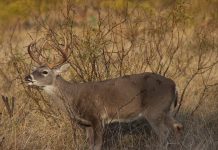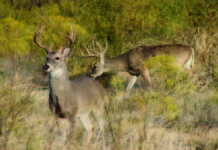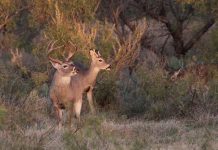Revelations this week by Texas wildlife officials that more than 200 white-tailed deer were euthanized at a South Texas hunting ranch with a deer breeding operation highlight the threat of chronic wasting disease and the no-holds barred effort to keep it from creeping into the state.
Texas Parks and Wildlife Department‘s law enforcement division and its game wardens began investigating the Lonesome Bull Ranch near Sandia in December, focusing on its record-keeping requirements needed by deer breeders. The investigation included an in-depth look at whether whitetails at the ranch, which also houses dozens of varieties of exotic wildlife, were imported from other states — a violation of state wildlife regulations.
The only cases of chronic wasting disease in Texas were discovered in hunter-harvested mule deer in 2012 in far West Texas near the New Mexico border.
Texas shut down the importation of deer from other states more than a decade ago and has conducted a rigorous chronic wasting disease testing program. TPWD had received test results indicating no disease detection for more than 30,000 samples collected from wild deer around the state since the 2002-03 hunting seasons, according to agency figures. Most were collected from hunter-harvested deer.
New Mexico is among the states where chronic wasting disease has been confirmed, and the remote mountains that spill over into our neighbors to the west have harbored animals with the disease for some time.
However, deer aren’t the real danger in connection with chronic wasting disease. The real threat remains the unscrupulous individual attempting to make big bucks by illegally smuggling deer that pose the greatest threat to our native population pegged at roughly 4 million.
For that reason, the Texas Parks and Wildlife Department, in conjunction with the Texas Animal Health Commission and other state and national entities, has developed a surveillance plan and protocols aimed at discovering and containing any transmission among the state’s deer herds, which remain a multi-billion dollar cash cow. TPWD estimates more than 600,000 hunters have annually pursued deer during recent seasons, and deer hunting’s direct economic impact is more than $2 billion annually in Texas.
Deer breeding activities alone represent a $650 million industry, according to TPWD.
The TAHC has authority for reporting and tracking diseases in alternative livestock including elk, red deer and sika deer, and TPWD has authority over free-ranging white-tailed and mule deer. The agencies also share regulatory authority over captive deer held under the authority of breeder permits.
TPWD also has established strict requirements on the movement of whitetails and muleys from breeder facilities. They include meeting certification status conditions with the TAHC, Texas Veterinary Medical Diagnostic Laboratories and the agency itself. Penalties include losing qualified status to move animals for a year or more, which can hit breeders in the pocket book.
In the case of the Lonesome Bull Ranch, the spotlight may only get brighter, which could lead to harsher penalties.
What is Chronic Wasting Disease?
Chronic wasting disease is a fatal transmissible neurological disease in the family of infectious diseases that include bovine spongiform encephalopathy, commonly known as “mad cow disease,” scrapie in sheep, feline spongiform encephalopathy in cats in Europe, and Creutzfeldt-Jakob disease and a new variant in humans. chronic wasting disease is believed to be caused by a misfolded protein that replicates and infects normal proteins, according to researchers.
Chronic wasting disease is named for its symptoms, including appetite loss, weight loss, listlessness, excessive drooling, blank stares, decreased awareness and behavioral changes. The diagnosis of the disease can’t be made by symptoms since other toxic and neurological afflictions can cause an animal to exhibit similar symptoms, according to researchers.
Chronic wasting disease originally was discovered in captive Colorado animals 35 years ago. However, during the past five years the disease has been detected in free-ranging deer and elk in several surrounding states and Canada. In 2002, a year after Texas closed its borders to importation of deer due to disease risks, it was reported in free-ranging deer in South Dakota, Wisconsin, New Mexico, Illinois and Utah.
The disease, which has no known immunity or treatment, occurs via natural transmission in deer, elk and moose. However, research indicates that infection of livestock through natural pathways is unlikely. It should be noted that the disease has not shown the ability to jump the species barrier to humans, according to researchers.
Chronic wasting disease has been shown to affect the brain, spinal cord and other lymph areas of infected animals, but proper field dressing typically removes any of these sites and hunters are advised to also bone out their meat. If you take animals to be processed commercially, ask that the meat be handled separately from that of others, too. If you suspect an animal you harvest has some type of disease, wildlife officials urge you to keep the carcass refrigerated or on ice and contact biologists, and certainly don’t attempt to eat any of the meat.
One troubling aspect of the disease is proof that it can spread, remain dormant for years and still affect natural resources, according to researchers. Case in point: a shipment of elk from an infected herd in Canada to South Korea in 1997 went undetected for nearly 10 years. Despite tracing back the imported animals, which were euthanized for testing in 2005, chronic wasting disease persists in that country, TPWD officials said. The disease previously had been found only in Canada and the United States.
Eradication of the disease increasingly is expected to become less attainable if it spreads through more populations, according to researchers. That makes a surveillance plan critical to the earliest detection followed with an adequate response plan.
TPWD previously regulated the importation of white-tailed deer and mule deer through its scientific breeder permit program. TAHC entry requirements were incorporated into the permit program and deer imported from other states must have originated from herds enrolled in an official chronic wasting disease monitoring program for at least three years. In states where the disease was detected, the required monitoring period was extended to five years. Those frameworks still exist for the importation of other cervids including elk, red deer and sika deer.
The Largest Threat is from Humans
Billy Powell is the poster child for what state wildlife officials fear most.
Powell, until a couple of years ago was one of the more than 1,200 permitted deer breeders in Texas who represented an investment in roughly 80,000 captive deer.
Biologists received another chronic wasting disease scare in 2011 thanks to Powell, who pleaded guilty to felony offenses in connection with the smuggling of more than three dozen whitetails worth more than $800,000 from Pennsylvania, Indiana, Illinois and Ohio into Texas during a three-year timeframe.
As a result, more than 300 deer held illegally at his breeding facility in East Texas were tested for CWD and bovine tuberculosis, with a collective sigh of relief when the findings revealed no presence of any disease. Since there is no live-animal CWD test, all of the deer were euthanized and Powell was forced to foot the roughly $28,000 bill for the testing protocols. Powell also paid more than $1.5 million in fines and restitution for his actions.
What scared biologists most was the fact that a number of other deer breeding facilities had stock that had co-mingled with the animals that were tested. It also is known that chronic wasting disease has been documented in at least 10 counties in Illinois, TPWD officials noted at the time.
“People ask me if I’m confident we don’t have CWD in Texas after testing that many animals, and I tell them my confidence level grows each year,” Mitch Lockwood, TPWD’s big game program director, said previously in a news release. “But, that confidence drops to zero every time we learn about a deer being smuggled into the state. The threat is real and the consequences can be substantial; just ask any of those other states that are dealing with CWD in their deer herds.”
Information: Chronic Wasting Disease Alliance






















